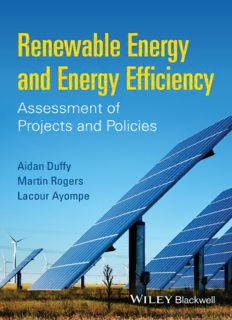
Renewable Energy and Energy Efficiency: Assessment of Projects and Policies PDF
Preview Renewable Energy and Energy Efficiency: Assessment of Projects and Policies
Renewable Energy and Energy Efficiency Renewable Energy and Energy Efficiency Assessment of Projects and Policies Aidan Duffy Professor SchoolofCivilandStructuralEngineering DublinInstituteofTechnology Martin Rogers SeniorLecturer DublinInstituteofTechnology Lacour Ayompe Researcher InternationalEnergyResearchCentre Thiseditionfirstpublished2015 ©2015byJohnWiley&Sons,Ltd Registeredoffice JohnWiley&Sons,Ltd,TheAtrium,SouthernGate,Chichester,WestSussex,PO198SQ, UnitedKingdom. Editorialoffices: 9600GarsingtonRoad,Oxford,OX42DQ,UnitedKingdom. TheAtrium,SouthernGate,Chichester,WestSussex,PO198SQ,UnitedKingdom. Fordetailsofourglobaleditorialoffices,forcustomerservicesandforinformationabouthowto applyforpermissiontoreusethecopyrightmaterialinthisbookpleaseseeourwebsiteat www.wiley.com/wiley-blackwell. Therightoftheauthortobeidentifiedastheauthorofthisworkhasbeenassertedin accordancewiththeUKCopyright,DesignsandPatentsAct1988. Allrightsreserved.Nopartofthispublicationmaybereproduced,storedinaretrievalsystem, ortransmitted,inanyformorbyanymeans,electronic,mechanical,photocopying,recordingor otherwise,exceptaspermittedbytheUKCopyright,DesignsandPatentsAct1988,withoutthe priorpermissionofthepublisher. Designationsusedbycompaniestodistinguishtheirproductsareoftenclaimedastrademarks. Allbrandnamesandproductnamesusedinthisbookaretradenames,servicemarks, trademarksorregisteredtrademarksoftheirrespectiveowners.Thepublisherisnotassociated withanyproductorvendormentionedinthisbook. LimitofLiability/DisclaimerofWarranty:Whilethepublisherandauthor(s)haveusedtheir besteffortsinpreparingthisbook,theymakenorepresentationsorwarrantieswithrespectto theaccuracyorcompletenessofthecontentsofthisbookandspecificallydisclaimanyimplied warrantiesofmerchantabilityorfitnessforaparticularpurpose.Itissoldontheunderstanding thatthepublisherisnotengagedinrenderingprofessionalservicesandneitherthepublisher northeauthorshallbeliablefordamagesarisingherefrom.Ifprofessionaladviceorother expertassistanceisrequired,theservicesofacompetentprofessionalshouldbesought. LibraryofCongressCataloging-in-PublicationDataappliedfor. ISBN:9781118631041 AcataloguerecordforthisbookisavailablefromtheBritishLibrary. Wileyalsopublishesitsbooksinavarietyofelectronicformats.Somecontentthatappearsin printmaynotbeavailableinelectronicbooks. Coverimage:iStockphoto©demachi. Typesetin10/12.5ptMinionProbyLaserwordsPrivateLimited,Chennai,India 1 2015 Contents Symbols,UnitsandAbbreviations ix AbouttheCompanionWebsite xv 1 Introduction 1 1.1 Background 2 1.2 Aim 4 1.3 Aspectsofrenewableenergyprojectappraisal 6 1.4 Booklayout 8 References 10 2 Technologies 11 2.1 Introduction 11 2.2 Keyconcepts 11 2.2.1 Heatofcombustion 12 2.2.2 Efficiency 12 2.2.3 Ratedpowerandenergy 12 2.2.4 Capacityandavailabilityfactors 13 2.2.5 Technologylearning 13 2.3 Electricalpowergeneration 14 2.3.1 Natural-gas-firedpowerplant 14 2.3.2 Coal-firedpowerplant 15 2.3.3 Hydropower 17 2.3.4 Windpower 19 2.3.5 Oceanenergy 22 2.3.6 Photovoltaics 25 2.4 Heatgeneration 28 2.4.1 Boilers 28 2.4.2 Solarwaterheaters 30 2.5 Combinedheatandpower 34 2.5.1 Micro-CHP 36 2.5.2 CHPengines 37 2.5.3 CHPturbines 37 2.5.4 Combinedheat,powerandcooling 38 2.6 Energystorage 39 2.6.1 Electrical 40 2.6.2 Pumpedhydroelectricstorage 40 2.6.3 Compressedairenergystorage 42 2.6.4 Thermalenergystorage 44 vi Contents 2.7 Energyefficiency 45 2.7.1 Thermalinsulation 46 2.7.2 High-efficiencylighting 48 References 50 3 ModellingEnergySystems 53 3.1 Introduction 53 3.2 System,modelandsimulation 54 3.2.1 Systems 54 3.2.2 Models 58 3.2.3 Simulation 71 3.3 Modellingandsimulatingenergysystems 76 3.3.1 Stepsinsimulatingenergyprojects 76 3.3.2 Simulationtools 79 3.3.3 Datasources 79 3.4 Casestudies 83 3.4.1 OfficePVsystem 83 3.4.2 Gasheatpumpfordataroomcooling 87 3.4.3 Compressedairenergystorage 90 3.5 Conclusions 93 References 95 4 FinancialAnalysis 97 4.1 Introduction 97 4.2 Fundamentals 98 4.2.1 Investorperspective 98 4.2.2 Typesofprojectsanddecisions 99 4.2.3 Cashflows 100 4.2.4 Realandnominalprices 104 4.2.5 Presentvalue 106 4.2.6 Discountrates 109 4.2.7 Taxationanddepreciation 112 4.2.8 Unequalprojectlifespan 114 4.3 Financialmeasures 116 4.3.1 Paybackanddiscountedpaybackperiods 117 4.3.2 Returnoninvestment 120 4.3.3 Profitabilityindexandsavings-to-investmentratio 121 4.3.4 Netpresentvalue 123 4.3.5 InternalRateofReturn 127 4.3.6 Lifecyclecost 131 4.3.7 LevelisedCostofEnergy 132 4.3.8 Uncertaintyandrisk 134 4.3.9 Financialmeasurescompared 136 Contents vii 4.4 Casestudies 139 4.4.1 Municipalbusfleetconversiontocompressed naturalgas 139 4.4.2 Newwindfarmdevelopment 142 4.5 Conclusion 148 References 149 5 Multi-CriteriaAnalysis 151 5.1 General 151 5.2 Simplenon-compensatorymethods 152 5.2.1 Introduction 152 5.2.2 Dominance 153 5.2.3 Satisficingmethods 155 5.2.4 Sequentialeliminationmethods 157 5.2.5 Attitude-orientedmethods 158 5.3 Simpleadditiveweightingmethod 160 5.3.1 Basicsimpleadditiveweightingmethod 160 5.3.2 SensitivityanalysisofbaselineSAWresults 163 5.3.3 Assigningweightstothedecisioncriteria 164 5.4 Analytichierarchyprocess 168 5.4.1 Introduction 168 5.4.2 Hierarchies 169 5.4.3 Establishingprioritieswithinhierarchies 169 5.4.4 Establishingandcalculatingpriorities 171 5.4.5 Derivingprioritiesusinganapproximationmethod 172 5.4.6 Derivingexactprioritiesusingtheiterative Eigenvectormethod 173 5.5 Concordanceanalysis 181 5.5.1 Introduction 181 5.5.2 PROMETHEEI 184 5.5.3 ELECTRETRI 188 5.6 Siteselectionforwindfarms – acasestudyfromCavan (Ireland) 189 5.6.1 Introduction 189 5.6.2 Nationalandinternationalguidance 189 5.6.3 Decisionframeworkchosen 194 5.6.4 Decisionmodelutilisedtocategoriseeachofthe18 sites 195 5.6.5 Selectionofpotentiallysuitablesites 198 5.6.6 Concludingcommentoncasestudies 198 5.7 ConcludingcommentsonMCDAmodels 200 References 202 viii Contents 6 PolicyAspects 203 6.1 Energypolicycontext 203 6.2 Energypolicyoverview 206 6.2.1 Policyinstrumentsandtargets 206 6.2.2 Designingpolicyinstruments 208 6.3 Marginalabatementcost 210 6.3.1 Environmentallifecycleassessment 211 6.3.2 Estimatingmarginalabatementcosts 221 6.4 Subsidydesign 224 6.4.1 Typesofenergysubsidies 224 6.4.2 Calculatingfeed-in-tariffs 226 6.5 Socialcost–benefitanalysis 230 6.5.1 Definetheobjectiveandidentifybasecase 231 6.5.2 Identifycostsandbenefits 231 6.5.3 Valuecostsandbenefits 233 6.5.4 Discountthecostsandbenefits 235 6.5.5 Interpretresults 237 6.5.6 Assesswhobearsthecostsandbenefits 237 6.5.7 Uncertainty 238 6.5.8 Makedecision 238 6.6 Casestudies 238 6.6.1 Marginalabatementcostsofemissionmitigation optionsinabuildingestate 238 6.6.2 PVfeed-in-tariffdesign 243 6.7 Conclusions 248 References 248 AppendixA:TableofDiscountFactors 251 Index 253
Description: